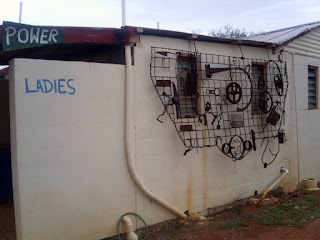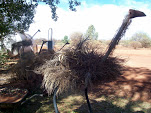I wanted to explore the idea that women are at the forefront of rural wellbeing because of their involvement and leadership in the arts and other creative pursuits in rural Western Australia. “Not the bread and butter, but definitely the jams and creams” was the title my husband came up with for a presentation I prepared for the Engendering Leadership conference at UWA in Perth, so I wanted to share some of that information in this entry. The presentation focused on how the role of women in the leadership of the “jams and creams” organisations (that is arts, social, support, charity & fundraising organisations) has greatly enriched the social landscape of rural communities by building and strengthening social bonds & networks, identity, sense of place and resilience in rural WA.
The idea for the presentation came while I was on the road in the focus region for my PhD research. It had occurred to me that men were largely underrepresented in my sample. This is not unusual for the arts sector, but I wasn’t just talking to artists and artsworkers. I’d been talking to a range of community groups and service organisations, shires and so on. But very few men were answering the phone. If I did happen to get hold of a male sounding voice, it was more often than not that I was referred on to the secretary, or the subcommittee, inevitably, referring me on to a woman.
This got me thinking about gender issues, so I set about doing some research (surprise, surprise). A federal government report entitled ‘A Snapshot of Women’s Representation on Selected Regional Bodies’ released in 2005 found that women in rural and regional Australia continue to be underrepresented in roles that involve management and decision making. Specifically, the representation of women is lowest on regional industry boards (0-21%), and highest (though still not equal with men) in regional organisations, such as areas consultative committees, development boards and catchment management authorities (12-41%).
This contradicts what I have been finding. Reports such as these seem to be asking, ‘well, where are the women?’ Whereas in my research so far I’ve been left wondering, ‘where are all the men?’
According the 2006 census ‘rural balance’ the split is fairly even with 53% men and 47% women. A trawl through some other figures, stats and research suggests that while women are much less likely than their brothers to inherit the family farm or rural town business, they are more socially mobile than men (that is they move around more to take advantage of education and employment opportunities). While men dominate the resources, construction and primary industries, women dominate education, health & finance.
In the arts and cultural sector there are more women than men involved in event organising, performing arts, craft and visual art. Yet more men than women are involved in radio, TV, design & music.
There are problems with relying on statistics though. Across the nation women are underrepresented in the role they actually do, due to their nature in both the workforce (which is overly part time & casual) and the amount of time and energy dedicated to voluntary work and unpaid domestic labour. The man might be the figure head for a number of social, economic, or arguably, practical reasons, but how much of “his work” would be possible without the contribution of his spouse or female colleagues?
Arts stats are even more difficult to decipher, firstly because there is no rural/urban split in the data, but also because arts activity and events occur outside of the so-called ‘arts and cultural sector’. For example, I was told about a Mother’s Group that has been doing screen printing. It’s not a screen printing group, it’s a mothers group, but they’re doing arts activities. There are also examples of a Women’s Domestic Violence Service that uses their office and counselling space for painting. It’s not a painting group, it’s a Domestic Violence Service, but the women (mostly indigenous women) can go there and paint. They have a safe place where they can get out of their household and take time out from their families and domestic situation and spend some time for themselves. The primary purpose isn’t the art, the primary purpose was to get women comfortable going to the centre allowing them access to the service if they choose to use it.
Rural women have a strong history of networking (just look at the CWA, for example). They provide vital services and support for their community through a myriad of voluntary organisations and groups throughout rural Australia. However, changes to farming life as a result of rural restructuring, droughts, rising input costs, etc., means women have less time and energy for volunteering which has an impact on the social wellbeing of the community. Women not only take on more outside physical work, but also juggle being a mum, bookkeeper, recording duties, farm correspondence, off-farm work and other activities (like growing vegetables, keeping poultry, or organising tourist accommodation & tours) to alleviate financial pressure on the farm and their families.
“I used to have a son on the farm, but he’s gone. Now I’m the son [laughs]
“For my father-in-law, women were barefoot and pregnant and it was a real shock when I came up. I’m out on the tractor. I’m out doing sheep work. Its just our generation, you just do it.”
"I've been lucky, I've got a good husband and a daughter at home and I've been able to put the time into it, but anyone else couldn't, and this was all done for free" - Founder & former chair, regional arts council“There used to be pottery, china painting, oil painting and sewing and there was decoupage as well, felting, spinning, weaving. Some have moved on, a lot of those people, but the next generation is not interested in art. You look at the age group it just keeps going up. They’re all encouraged to go to work.”
“She’s right, it’s because they’re so busy and they’ve got children and it’s a different way of how we were, because I was always home just raising my children and I had a job at home that I did at night time. But during the day you’d go out and do everything and organise the open days and things like that.”
Due to the tough times that everyone is facing the men are also stepping down from their previously very public roles in communities. As such that the nature of the rural community that revolves around sport and the local public house is also changing.
“Once your football side goes and the pub, well nobody goes there. Your town’s dying”. In the same breathe this interviewee also stated that there must be a lot going on because she was out every day of the week.
The men are more busy and consumed with their work and their businesses, in some regions, they are also working more off the farm in nearby mining towns in order to supplement the lack in farming incomes.
“The men are busy. They’re focused on their farms. If you rang my husband he’ll say, well speak to my wife, cos I’m busy, he’ll find something to do.”
There might not be a footy team, and of the three pubs once operating, the last one still open is in a sad state. The population is on the decline and most shop fronts are empty, but women have held on to their spaces. Women are making a visual statement in their towns by claiming back the old buildings of a thriving past for use as art, craft and community centres. The most visual of these is the use of public art and murals that brighten up the visual appeal of a community, making a very public visual statement about the town and the people that live there.
The role that women play in rural Australia is recognised and greatly appreciated by their husbands, families and the communities that rely and depend upon their generosity and service. They manage their homes, their children, the farms finances, and more, while still finding time to contribute, usually on a voluntary basis, to their communities vital services including charity & service organisations, tourism, agricultural shows, expos and opens days, they belong to craft groups, painting groups, conservation groups, development councils, and so on.
We have come a long way in recognising and legitimising the roles and contribution of women in rural Australia, but there is still a long way to go. For example, only a couple of years ago there was a free inoculation for Q fever for all farmers. Not too many women did turn up, but because the inoculation was for farmers, and this particular programme did not recognise women as farmers, it was not free for women. In one district, the only two people who showed evidence of having the disease was the two women who decided to go ahead with the test anyway. It was a disease that can only be contracted mainly by contact with droppings, urine or milk from stock. In this particular district, few men assist with the delivery of sheep, goats & cattle and thus would not have come in contact with the disease.
Still a long way to go.















